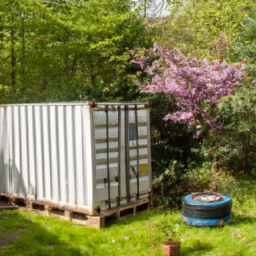Living off the grid has become increasingly popular in the UK, and one question that frequently arises is whether it is permissible to bury a shipping container in the garden. This practice offers a unique solution for additional storage space or even creating a hidden underground living area. However, before proceeding with such a project, it is essential to consider local regulations, potential environmental impact, and practicality. This article examines the feasibility of burying shipping containers in UK gardens, exploring the legalities, planning permissions required, and the potential advantages and disadvantages of this unconventional approach to off grid living.
Off Grid Living
Living off the grid has become an increasingly popular lifestyle choice for individuals seeking independence from traditional utility services. This alternative way of living allows individuals to generate their own power, collect and store rainwater, and create sustainable systems for waste disposal. One question that frequently arises among those interested in off grid living is whether it is possible to bury a shipping container in a garden in the UK. In this article, we will explore the rules, regulations, and considerations surrounding this topic in order to provide a comprehensive guide for those interested in pursuing this option.
Can I Bury a Shipping Container in My Garden UK?
Rules and Regulations
Before embarking on any construction project, it is crucial to understand the rules and regulations governing the process. In the case of burying a shipping container in a garden in the UK, there are several factors to consider. Firstly, it is important to check with the local authority or council to ascertain whether such an endeavor is permissible in the designated area. Additionally, building regulations and planning permission need to be carefully examined to ensure compliance with the law.
Planning Permission
In the UK, planning permission is often required for any significant construction projects. This includes burying a shipping container in a garden. However, the need for planning permission may vary depending on factors such as the size of the container, location, and intended use. It is advisable to consult with the local planning department to determine whether obtaining planning permission is necessary for your particular circumstances.
Building Regulations
Apart from planning permission, building regulations also play an important role in determining the feasibility of burying a shipping container in your garden. These regulations are in place to ensure the safety and structural integrity of any construction project. It is essential to check whether the specific modifications and additions made to the container comply with building regulations to ensure a safe and secure end result.
Environmental Considerations
When contemplating burying a shipping container in a garden, it is crucial to consider the environmental impact of such a decision. The ground in which the container will be buried needs to be assessed for factors such as soil composition, drainage, and impact on the local ecosystem. Additionally, it is important to evaluate any potential risks to underground utilities and water sources.
Utility Connections
Living off the grid often entails disconnecting from traditional utility services. However, it is important to consider whether any utility connections will be required within the buried shipping container. This could include electricity, water supply, or waste disposal systems. The feasibility and practicality of establishing these connections should be carefully evaluated before proceeding with the project.
Structural Integrity
One of the main concerns when burying a shipping container in a garden is ensuring its structural integrity. Containers are designed to support weight on their corners, so burying one without appropriate reinforcement could compromise the container’s ability to withstand underground pressure. Consulting with a structural engineer or an expert in container modifications is crucial to ensure the safety and stability of the buried container.
Ground Preparation
Successful burial of a shipping container requires careful ground preparation. This involves preparing the ground to resist groundwater infiltration, stabilizing the soil, and ensuring proper drainage. It is necessary to excavate the area to an appropriate depth, taking into consideration any local regulations and the intended use of the buried container.
Container Modifications
Before burying a shipping container, it is essential to consider any necessary modifications. Reinforcing the container to withstand the external pressure exerted by the soil is crucial. Additionally, proper ventilation, moisture control, and insulation must be addressed to ensure a safe and habitable environment inside the container. Seeking expert advice can provide valuable insights into the required modifications for the specific purposes of the project.
Access and Security
When burying a container in a garden, it is important to consider access and security. Adequate measures must be taken to ensure easy entry and exit from the container, especially in emergency situations. Additionally, steps must be taken to prevent unauthorized access and protect the container and its occupants from potential risks such as theft or vandalism.
Alternative Options
While burying a shipping container in a garden may seem like an appealing option for off-grid living, it is essential to explore alternative options as well. Depending on individual circumstances and preferences, alternatives such as utilizing above-ground containers, creating separate structures, or utilizing alternative off-grid housing options may be more suitable. It is crucial to thoroughly research and consider all available options before committing to burying a shipping container in a garden.
In conclusion, burying a shipping container in a garden in the UK for off-grid living purposes requires careful consideration of rules, regulations, and various factors. It is crucial to investigate local planning permission requirements, comply with building regulations, and ensure the structural integrity of the container. Environmental considerations, utility connections, ground preparation, container modifications, and access and security are also crucial factors to be addressed. Exploring alternative options is recommended to find the most appropriate approach for individual circumstances. By conducting thorough research and seeking professional advice, individuals can make informed decisions and pursue their off-grid living goals responsibly and legally.




